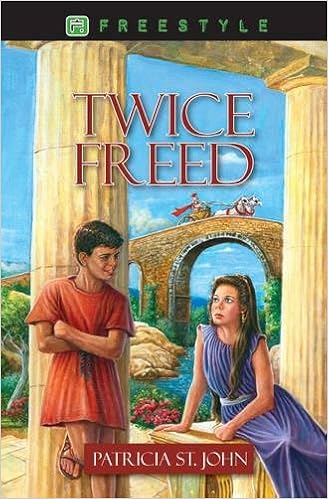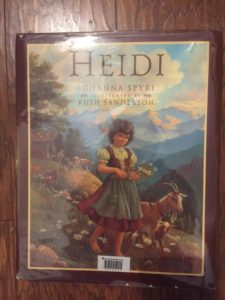 I’ve been reading An Ordinary Woman’s Extraordinary Faith: The Autobiography of Patricia St. John. IT’s quite a good story, and it makes me long for a time “when life was simple back in the good old days.” She says things that would in our time be taken as evidence of dishonesty neglect, or dysfunction, and as I read, I knew that they were neither. For instance, her mother and father lived apart for many of the years of their marriage, she taking care of the children in England and he traveling the world and teaching the Bible. And Patricia St. John writes that she never heard an argument or even a cross word pass between her parents when they were together. She also writes of her childhood in which she and her siblings were allowed to explore the woods and fields near their country home, being gone all day and only coming home in time for supper and bed. She tells the story of living alone in a Muslim village in Morocco, with no telephone, no English-speaking people living nearby, and very little knowledge of the Arabic language. She fed the beggar children and told them stories about Jesus in broken Arabic. I fear we have come a long way from the 1950’s when Patricia St. Joh was a missionary in Morocco, and even farther from her childhood in 1930’s and 40’s Britain. And I’m not sure that our sophistication and dependence on technology has brought us to a better way of life or of evangelism in many ways.
I’ve been reading An Ordinary Woman’s Extraordinary Faith: The Autobiography of Patricia St. John. IT’s quite a good story, and it makes me long for a time “when life was simple back in the good old days.” She says things that would in our time be taken as evidence of dishonesty neglect, or dysfunction, and as I read, I knew that they were neither. For instance, her mother and father lived apart for many of the years of their marriage, she taking care of the children in England and he traveling the world and teaching the Bible. And Patricia St. John writes that she never heard an argument or even a cross word pass between her parents when they were together. She also writes of her childhood in which she and her siblings were allowed to explore the woods and fields near their country home, being gone all day and only coming home in time for supper and bed. She tells the story of living alone in a Muslim village in Morocco, with no telephone, no English-speaking people living nearby, and very little knowledge of the Arabic language. She fed the beggar children and told them stories about Jesus in broken Arabic. I fear we have come a long way from the 1950’s when Patricia St. Joh was a missionary in Morocco, and even farther from her childhood in 1930’s and 40’s Britain. And I’m not sure that our sophistication and dependence on technology has brought us to a better way of life or of evangelism in many ways.
While Ms. St. John was living in England (during WWII) and in Morocco, she also wrote fiction books for children, books that give a vivid picture of other lands such as Switzerland and Morocco and also a believable and simple vision of the power of the gospel to change lives and comfort the afflicted. The following titles are the ones I have in my library:
 Her first book, The Tanglewood’s Secret, was written to comfort and strengthen the girls in a boarding school that Ms. St. John’s family was associated with. Ruth, the main character in the book, lives with her aunt in the English countryside, and although she begins as a rather selfish and unhappy girl, she later comes to know the Good Shepherd who cares for His sheep.
Her first book, The Tanglewood’s Secret, was written to comfort and strengthen the girls in a boarding school that Ms. St. John’s family was associated with. Ruth, the main character in the book, lives with her aunt in the English countryside, and although she begins as a rather selfish and unhappy girl, she later comes to know the Good Shepherd who cares for His sheep.
Treasures of the Snow is set in Switzerland, where Patricia and her family spent a year of her childhood. In the story a girl named Annette is filled with hatred for Lucien, the boy responsible for an injury that crippled Annette’s little brother. The bitterness and hatred in Annette’s heart poisons all of her life and her relationships until she learns to forgive.
Star of Light is the first book that Patricia St. John wrote about her mountain village in Morocco. It’s fiction, but based untrue stories of how Jesus and a missionary nurse healed and cared for a blind baby and a beggar boy.
In Rainbow Garden, Elaine is sent to live with a family in the English countryside while her mother goes to work in France. Elaine is selfish and bitter, but she experiences healing and forgiveness in her garden.
Three Go Searching was written while Ms. St. John was a missionary nurse in an Arab village. When Waffi, an Arab boy, and David, a missionary kid, find a sick servant girl and a mysterious boat, and thus begins an exciting adventure.
The Secret of the Fourth Candle, also written during the time in the Moroccan village, consists of three short stories: “The Four Candles”, “The Cloak”, and “The Guest”.
 Historical fiction set during the first century, The Runaway tells the story of Philo, a Phoenician boy whose little sister Illyrica is possessed by a demon. Philo finds a way to take his sister to Jesus, the healer.
Historical fiction set during the first century, The Runaway tells the story of Philo, a Phoenician boy whose little sister Illyrica is possessed by a demon. Philo finds a way to take his sister to Jesus, the healer.
Twice Freed is the fictionalized story of Onesimus, the runaway slave who returns to his master with a letter, the Book of Philemon in the the Bible.
Patricia St. John also wrote several missionary biographies, including Until the Day Breaks: The Life and Work of Lilias Trotter, Pioneer Missionary to Muslim North Africa, a book I would like to acquire and read someday.




